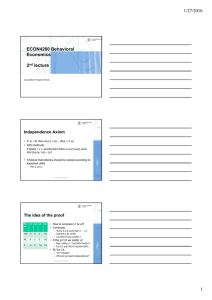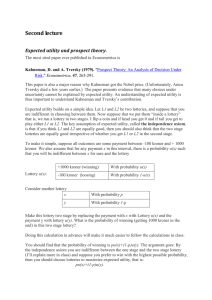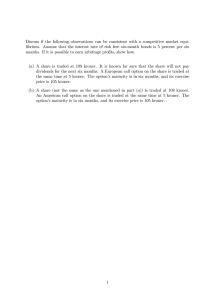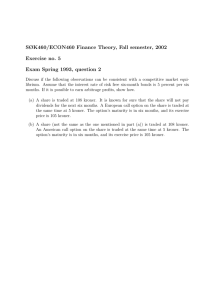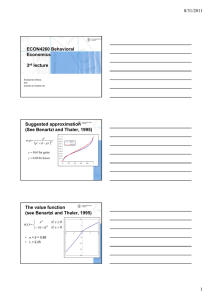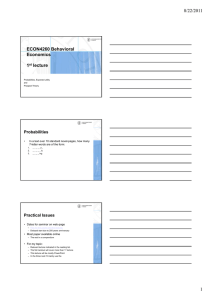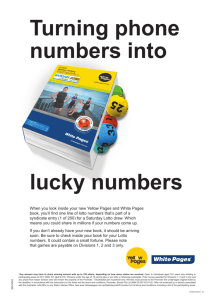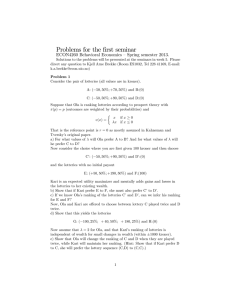8/30/2011 ECON4260 Behavioral
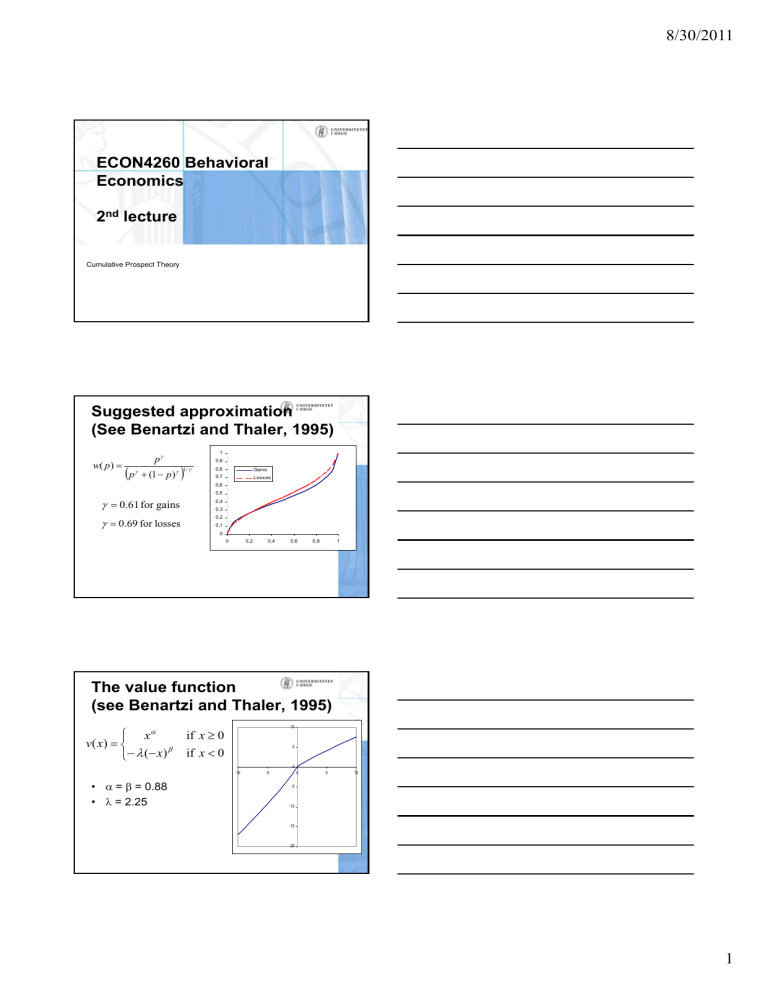
ECON4260 Behavioral
Economics
2
nd
lecture
Cumulative Prospect Theory
Suggested approximation
(See Benartzi and Thaler, 1995)
w ( p )
p
p
( 1
p )
1 /
0 .
61 for gains
0 .
69 for losses
1
0,9
0,8
0,7
0,6
0,5
0,4
0,3
0,2
0,1
0
0 0,2
Gains
Losses
0,4 0,6 0,8 1
The value function
(see Benartzi and Thaler, 1995)
10 v ( x )
x
(
x )
if x
0 if x
0
5
0
• = = 0.88
• = 2.25
-5
-10
-15
-20
8/30/2011
1
Evidence; Decision weights
• Problem 3
– A: (4 000, 0.80) or B: (3 000)
– N=95 [20] [80]*
• Problem 4
– N=95 [65]* [35]
• Violates expected utility
– B better than A : u(3000) > 0.8 u(4000)
– C better than D: 0.25u(3000) > 0.20 u(4000)
• Perception is relative:
– 100% is more different from 95% than 25% is from 20%
Lotto
• 50% of the money that people spend on Lotto is paid out as winning prices
• Stylized:
– Spend 10 kroner
– Win 1 million kroner with probability 1 to 200 000
• Would a risk avers expected utility maximizer play
Lotto?
– Is Lotto participation a challenge to expected utility?
• Can prospect theory explain why people participate in Lotto?
• What is maximum willingness to pay for this winning prospect, for an
– Risk avers expected utility maximizer?
– A person acting acording to prospect theory?
Suggested answer
• A risk neutral expected utility maximizer will value the winning prospect to the expected value
– 1 million kroner* (1/200 000) = 5 kroner
– WTP for a risk avers person < 5 kroner
• Prospect theory
– = w(1/200 000) ≈ 0 0002
– v(1 million) = (1 000 000)^0.88 ≈ 190 000
– WTP = x where: 2.25(x)^0.88 ≈ 190 000 * 0,0002
– Solution: WTP ≈ 27.5 kroner
– Would buy Lotto even with only 2 kroner expected value for each 10 kroner spent. (5 kroner/2.7)
• Some people do NOT buy Lotto tickets
– Is that a challenge to CPT?
8/30/2011
2
Value function
Reflection effect
• Problem 3
– A: (4 000, 0.80) or B: (3 000)
– N=95 [20]
• Problem 3’
[80]*
– A: (-4 000, 0.80) or B: (-3 000)
– N=95 [92]* [8]
• Ranking reverses with different sign (Table 1)
• Concave (risk aversion) for gains and
• Convex (risk lover) for losses
The reference point
• Problem 11: In addition to whatever you own, you have been given 1 000. You are now asked to choose between:
– A: (1 000, 0.50) or B: (500)
– N=95 [16] [84]*
• Problem 12: In addition to whatever you own you have been given 2 000. You are now asked to choose between:
– A: (-1 000, 0.50) or B: (-500)
– N=95 [69]* [31]
• Both equivalent according to EU, but the initial instruction affect the reference point.
Isolation Effect
(recall the independence axiom)
”In order to simplify the choice between alternatives, people often disregard components that the alternatives share and focus on the components that distinguishes them”
• Problem 10:
Consider the two-stage game. The first stage is (2. stage,
0.25; 0, 0.75) (proceed to stage to with 25% probability. If you reach the second stage you have the choice between
A: (4000, 0.80) and B (3000) [78%]. Your choice must be made before the game starts.
• The choice in 10 is equivalent to.
A’: (4000, 0.20) [65%] and B’: (3000,0.25)
8/30/2011
3
Why not make the distinction of losses and gains in expected utility?
• A person participate in a lottery (-1000,50%)
– If he loses his budget set will be
• All consumption bundles such that
• W-1000 > 0 n i
1 x i p i
W
1000
– If he not lose his budget set will be n i
1 x i p i
W
– Indirect utility u(W) or u(W-1000)
• Standard economics see lotteries as adding uncertainty to overall income/wealth
• We derive utility from commodities not money
• This is not an implication of the independence axiom
The editing phase
Finding the reference point
• Combination
(200,0.25,200,0.25) =(200,0.5)
• Segregation
(300,0.8;200,0.2)=200 + (100,0.8)
• Cancellation
(200,0.2;100,0.5;-50,0.3) vv (200,0.2;150,0.5;-100,0.3)
Can be seen as a choice between
(100,0.5;-50,0.3) vv (150,0.5;-100,0.3)
• Simplifications
– (500,0.2 ; 99,0.49) dominates
(500,0.15; 101,0.51) if the last part is simplified to
(… ; 100,0.50)
Stochastic dominance
Lottery A (58%) White red
Probability %
Price
90
0
6
45 green
1
30
Lottery B (42%)
Probability %
Price
White
90
0 red
7
45 green
1
-10
Prob. %
Lottery C (A)
Lottery D (B)
0
0
White
90 red
6
45
45 green
1
30
45 blue
1
-15
-10 yellow
3
-15 yellow
2
-15 yellow
2
-15
-15
8/30/2011
4
The status of cumulative prospect theory
(See Starmer 2000)
• Explains data much better than alternative theories.
– Rank dependent utility, does a fair job but not as good
• But limited impact on economic theory
• But, some very interesting application
– We will use it to understand equity return
• See Camerer 2000 for other examples.
Rabin’s Theorem
A teaser
• How many of you would participate in the following lotteries (the alternative is (0)).
– A: (-100, 33 %, +100, 67 %)
% %)
– C: (-100, 85 %, +10 billions, 15%)
– D: (-100, 50 %, +10 billions, 50%)
• Would changes in wealth (±10 000 kroner) affect your preferences?
The brain is highly specialized
Department of
Economics
8/30/2011
5
